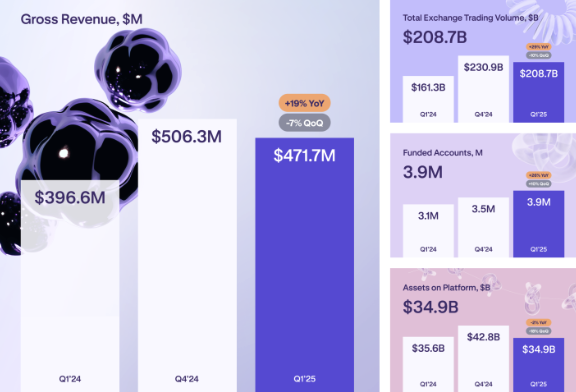| COINOTAG recommends • Exchange signup |
| 💹 Trade with pro tools |
| Fast execution, robust charts, clean risk controls. |
| 👉 Open account → |
| COINOTAG recommends • Exchange signup |
| 🚀 Smooth orders, clear control |
| Advanced order types and market depth in one view. |
| 👉 Create account → |
| COINOTAG recommends • Exchange signup |
| 📈 Clarity in volatile markets |
| Plan entries & exits, manage positions with discipline. |
| 👉 Sign up → |
| COINOTAG recommends • Exchange signup |
| ⚡ Speed, depth, reliability |
| Execute confidently when timing matters. |
| 👉 Open account → |
| COINOTAG recommends • Exchange signup |
| 🧭 A focused workflow for traders |
| Alerts, watchlists, and a repeatable process. |
| 👉 Get started → |
| COINOTAG recommends • Exchange signup |
| ✅ Data‑driven decisions |
| Focus on process—not noise. |
| 👉 Sign up → |
-
Kraken has showcased impressive financial growth in Q1 2025, leveraging market volatility and strategic expansions to enhance its position in the cryptocurrency trading landscape.
-
The exchange’s innovative initiatives, such as acquiring NinjaTrader and launching a FIX API, have significantly increased trading volumes and user engagement.
-
Despite these achievements, Kraken must navigate challenges from competitors like Coinbase and Binance, along with ongoing regulatory scrutiny and market fluctuations.
Kraken reports $472 million in Q1 2025 revenue, aided by strategic expansions and Bitcoin volatility, but faces tough competition in the evolving crypto landscape.
Overview of Kraken’s Q1 2025 Financial Performance
Data from Kraken reveals that its gross revenue reached $472 million, marking a 19% year-on-year growth from 2024. The company’s adjusted earnings before interest, taxes, depreciation, and amortization (EBITDA) stood at $187.4 million. This reflects a 17% increase over the same period.

This growth occurred amid significant volatility in the cryptocurrency market, particularly during the first 100 days of President Donald Trump’s second term, as pro-crypto policies spurred heightened trading activity. Several factors contributed to this performance.
| COINOTAG recommends • Professional traders group |
| 💎 Join a professional trading community |
| Work with senior traders, research‑backed setups, and risk‑first frameworks. |
| 👉 Join the group → |
| COINOTAG recommends • Professional traders group |
| 📊 Transparent performance, real process |
| Spot strategies with documented months of triple‑digit runs during strong trends; futures plans use defined R:R and sizing. |
| 👉 Get access → |
| COINOTAG recommends • Professional traders group |
| 🧭 Research → Plan → Execute |
| Daily levels, watchlists, and post‑trade reviews to build consistency. |
| 👉 Join now → |
| COINOTAG recommends • Professional traders group |
| 🛡️ Risk comes first |
| Sizing methods, invalidation rules, and R‑multiples baked into every plan. |
| 👉 Start today → |
| COINOTAG recommends • Professional traders group |
| 🧠 Learn the “why” behind each trade |
| Live breakdowns, playbooks, and framework‑first education. |
| 👉 Join the group → |
| COINOTAG recommends • Professional traders group |
| 🚀 Insider • APEX • INNER CIRCLE |
| Choose the depth you need—tools, coaching, and member rooms. |
| 👉 Explore tiers → |
First, the price volatility of Bitcoin and other major cryptocurrencies drove a surge in trading volumes across the industry. According to COINOTAG data, Bitcoin’s price rose from $69,000 at the start of 2025 to over $94,000 by the end of March, representing a 35% increase.
This growth was bolstered by positive community sentiment following the Trump administration’s plans to establish a national Bitcoin reserve. Against this backdrop, Kraken capitalized on the increased trading wave, with its platform’s trading volume rising by 29%, directly contributing to its revenue growth.
| COINOTAG recommends • Exchange signup |
| 📈 Clear interface, precise orders |
| Sharp entries & exits with actionable alerts. |
| 👉 Create free account → |
| COINOTAG recommends • Exchange signup |
| 🧠 Smarter tools. Better decisions. |
| Depth analytics and risk features in one view. |
| 👉 Sign up → |
| COINOTAG recommends • Exchange signup |
| 🎯 Take control of entries & exits |
| Set alerts, define stops, execute consistently. |
| 👉 Open account → |
| COINOTAG recommends • Exchange signup |
| 🛠️ From idea to execution |
| Turn setups into plans with practical order types. |
| 👉 Join now → |
| COINOTAG recommends • Exchange signup |
| 📋 Trade your plan |
| Watchlists and routing that support focus. |
| 👉 Get started → |
| COINOTAG recommends • Exchange signup |
| 📊 Precision without the noise |
| Data‑first workflows for active traders. |
| 👉 Sign up → |
Additionally, Kraken made strategic moves to expand its operations. The company’s official blog on May 1, 2025, revealed the launch of an institutional-grade FIX API for futures trading, boosting monthly trading volumes by 250%.
Furthermore, Kraken’s $1.5 billion acquisition of NinjaTrader in March 2025 enabled the exchange to onboard nearly 2 million new traders and expand into asset classes beyond cryptocurrencies. These initiatives demonstrate Kraken’s efforts to diversify its services and seize market opportunities.
| COINOTAG recommends • Traders club |
| ⚡ Futures with discipline |
| Defined R:R, pre‑set invalidation, execution checklists. |
| 👉 Join the club → |
| COINOTAG recommends • Traders club |
| 🎯 Spot strategies that compound |
| Momentum & accumulation frameworks managed with clear risk. |
| 👉 Get access → |
| COINOTAG recommends • Traders club |
| 🏛️ APEX tier for serious traders |
| Deep dives, analyst Q&A, and accountability sprints. |
| 👉 Explore APEX → |
| COINOTAG recommends • Traders club |
| 📈 Real‑time market structure |
| Key levels, liquidity zones, and actionable context. |
| 👉 Join now → |
| COINOTAG recommends • Traders club |
| 🔔 Smart alerts, not noise |
| Context‑rich notifications tied to plans and risk—never hype. |
| 👉 Get access → |
| COINOTAG recommends • Traders club |
| 🤝 Peer review & coaching |
| Hands‑on feedback that sharpens execution and risk control. |
| 👉 Join the club → |
Challenges and Future Outlook
Despite the positive results, Kraken faces several challenges moving forward.
First, competition within the industry is intensifying as major exchanges like Coinbase and Binance continue to expand their market share. This competitive pressure requires Kraken to innovate and enhance its services to continually retain customers.
Second, the reliance on market volatility to drive revenue poses a significant risk, particularly if the crypto market enters a phase of consolidation or decline. Finally, regulatory pressures in the US and globally remain critical to monitor, as any policy changes could impact Kraken’s operations.
On the outlook front, Kraken plans to expand into the Asian market, where crypto user growth is accelerating. The launch of Kraken Pay and the expansion of on-chain staking in Q1 2025 also indicate the company’s efforts to diversify revenue streams. However, to sustain its growth momentum, Kraken must develop a long-term strategy to reduce its dependence on market volatility and strengthen its competitive edge against rivals.
| COINOTAG recommends • Exchange signup |
| 📈 Clear control for futures |
| Sizing, stops, and scenario planning tools. |
| 👉 Open futures account → |
| COINOTAG recommends • Exchange signup |
| 🧩 Structure your futures trades |
| Define entries & exits with advanced orders. |
| 👉 Sign up → |
| COINOTAG recommends • Exchange signup |
| 🛡️ Control volatility |
| Automate alerts and manage positions with discipline. |
| 👉 Get started → |
| COINOTAG recommends • Exchange signup |
| ⚙️ Execution you can rely on |
| Fast routing and meaningful depth insights. |
| 👉 Create account → |
| COINOTAG recommends • Exchange signup |
| 📒 Plan. Execute. Review. |
| Frameworks for consistent decision‑making. |
| 👉 Join now → |
| COINOTAG recommends • Exchange signup |
| 🧩 Choose clarity over complexity |
| Actionable, pro‑grade tools—no fluff. |
| 👉 Open account → |
Conclusion
In summary, Kraken’s impressive Q1 2025 financial results reflect a moment of growth fueled by strategic expansions and market volatility. However, as competition intensifies and regulatory concerns loom, the exchange’s future success will rely on its ability to innovate and adapt effectively. Engaging with emerging markets and diversifying its revenue streams will be critical for sustaining its growth.
| COINOTAG recommends • Members‑only research |
| 📌 Curated setups, clearly explained |
| Entry, invalidation, targets, and R:R defined before execution. |
| 👉 Get access → |
| COINOTAG recommends • Members‑only research |
| 🧠 Data‑led decision making |
| Technical + flow + context synthesized into actionable plans. |
| 👉 Join now → |
| COINOTAG recommends • Members‑only research |
| 🧱 Consistency over hype |
| Repeatable rules, realistic expectations, and a calmer mindset. |
| 👉 Get access → |
| COINOTAG recommends • Members‑only research |
| 🕒 Patience is an edge |
| Wait for confirmation and manage risk with checklists. |
| 👉 Join now → |
| COINOTAG recommends • Members‑only research |
| 💼 Professional mentorship |
| Guidance from seasoned traders and structured feedback loops. |
| 👉 Get access → |
| COINOTAG recommends • Members‑only research |
| 🧮 Track • Review • Improve |
| Documented PnL tracking and post‑mortems to accelerate learning. |
| 👉 Join now → |








